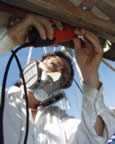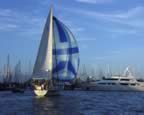|
Log - 1/5/2002 to 3/18/2002 In this section Alan tells about being stuck in the Nuevo Vallarta dockside vortex and our eventual escape to the lovely Chamela and Tenacatita bays. In March we returned to Nuevo Vallarta for the Banderas Bay Regatta. This long page includes the following sections:
The marina at the Paradise Village resort (in Nuevo Vallarta just north of Puerto Vallarta) is very spiffy, expensive, and filled with costly sail and power boats. We stayed at the Paradise marina for a week when our friend Amy, Katherine's Dad (George) and Stepmom (Blanche) visited for a couple weeks. Beyond the human augmented niceties of a high-end resort, Paradise Village is not a sensible stopover for a cost conscious cruiser. The prices are high and it is a long bus ride into Puerto Vallarta for supplies and affordable diversions. None-the-less we enjoyed a week of decadence, meeting other boaters, and visiting with friends, and family. Then, we moved the boat back to the cheap, dilapidated, and funky Marina Nuevo Vallarta for a month of boat fix-up. Contrary to popular belief, the cruising life is not filled with leisure. We often spend forty hours a week, or more, simply maintaining my floating home and ensuring that it will safely get us to our next destination. For example, during our stay in Nuevo Vallarta we accomplished the following boat projects:
Midnight Demon Attack The cruising life can be devastating. Recently, this region has had a wave of cruiser tragedies:
On February 12th we piled into a large van along with some other sailors and a local artist/guide and headed to San Sebastian, an old silver mining town in the mountains. It took three hours on a twisting, one-lane, dirt road to climb 30 miles into the mountains west of the Bay of Banderas. Native Indians acquired silver from this area since pre-Cortes. In 1890, the Mexican government permitted foreign mining companies, the population of the San Sebastian exploded to 22,000 people - mostly native indentured servants. Since the infrastructure to support thousands of miners and mules was built up during just a few years, the architecture is amazingly uniform. After the revolution in 1910, everyone left San Sebastian and the nearly depleted mines were closed. Today, only 450 people occupy this eerily empty town. Located in the transition between tropical and high-altitude forests, the San Sebastian vegetation is especially diverse and intriguing. Tropical bananas grow next to pine trees. Cross-pollination of nonindigenous species has led to a hundred varieties of plant life unique to this area; my favorite was a cross between passionfruit and eggplant. Immediately south of the Bay of Banderas lies the notorious Cabo Corrientes. Much like Point Conception in California, Corrientes is a point that sticks out into the pacific and often twists the weather to create its own nasty playground of high wind and waves. On February 11th we were finally ready to head south to Chamela. I received benign wind prediction via the weather fax; but, since there was an atypical weather pattern at the Nuevo Vallarta docks, we chose not to believe the fax. Instead we decided to go on the two-day inland trip to San Sebastian. Just before heading to San Sebastian our caution was validated by s/v The Great Escape. When they checked in on the Amigo radio net, The Great Escape reported winds up to 40 knots, with lightning, and rain while sailing around Cabo Corrientes. After the San Sebastian jaunt, we finally escaped Nuevo Vallarta. During an overnight trip we sailed around Cabo Corrientes with a pleasant ten-knot tailwind. We had to motorsail much of the rest of the way to Chamela; but that is much better than being caught in the 20-30 knot winds reported by a vessel that rounded the cape only four hours after we did. The black moonless night provide a glorious backdrop for a brilliant starry sky and the brightest bioluminescent plankton display I have ever witnessed. One if the many passing herds of dolphins, swam with us for a half hour. They weaved and played in our bow wave, all the while sheathed in streamers of fairy dust comprised of excited plankton. Disney still has a way to go to compete with mother nature. Chamela is splendid. There are lots of places to explore for snorkeling, a pristine beach to walk on as long as your legs can take it, and a couple small tiendas (stores) to get very basic supplies (including coconut water). The wind picks up almost every afternoon, so our wind generator kept our batteries charged. Entertainment is supplied by the pangas anchored with re-bar anchors. In the wind they occasionally drag away form shore, and through the main anchorage, threatening parked cruising vessels - until rescued by cruisers or other pangas. After gathering our Zen and recuperating from civilization, we continued southeast from Chamela to Careyes. Careyes consists of two tiny, attractive pocket anchorages. We tried to anchor in the sheltered north cove, which is the site of a temporarily closed Club Med. The tight quarters necessitate use of both bow and stern anchors to reduce the amount of swinging. After setting the stern anchor we dropped the bow anchor, which failed to hold. After repositioning the bow anchor, the stern anchor started dragging. While maneuvering to set the bow anchor and avoid another boat, the stern anchor line wrapped around the prop and killed the engine. I grabbed my mask, hopped overboard, and freed the prop - as Katherine went ballistic with anxious frustration. After freeing the propeller shaft, we reset the bow anchor and had a neighboring boat redrop the stern anchor using his dinghy. After the stern anchor failed to hold once again, we gave up, pulled in our ground tackle, and limped out of Careyes - frustrated and defeated. For people interested in anchoring in the north cove of Careyes, I make the following recommendations. Beware of the shale bottom that is deceptively covered with thin patches of sand. Before anchoring get your snorkeling gear, swim around, and identify where you want to anchor or tie off. If you want to anchor, manually probe the bottom and set your anchor. While the Club Med is closed, try tying a line onto a Club Med mooring or their dock pilings or a rock. Maybe a stern line could be tied off to someplace on shore. A 25-knot tailwind blew us dead downwind to Bahia Tenacatita at seven knots, using only the jib. Just before sunset (on February 28th) we simply dropped the hook and it held firmly. Tenacatita is an incredibly nice area. This scenic bay is very away from it all. The only town is a twenty-minute dinghy ride away - and it doesn't have much beyond basic sustenance items. A lot of nice cruisers hang out in the large anchorage. At long last we were reunited Jill and Brent, our friends on s/v Loncia. At Tenacatita we had a pleasant social life in the middle of nowhere. Although I went snorkeling five times, the visibility was rather poor (all along the Mexican mainland I have been disappointed by the underwater visibility). We took our dinghy up a narrow stream through a mangrove "jungle". After a few miles of winding through a mangrove corridor the placid stream curves Toward another bay that has a few motels and several palapa cafes on the beach. These thatched-roof, sand-floored, cafes are famous for tasty seafood rolls. The yummy rolls are cylindrical a shrimp and fish cakes served with a nut cream sauce. We did this jungle river trek on Friday because on Friday the local produce truck parks by the palapa restaurants. We were able to stock up on a variety of good, fresh fruits and vegetables for very little money. A vegetarian's food bill would be next to nothing here. Friday evening is also the silly, but fun, dinghy raftup/potluck party. One person goes out in their inflatable dinghy and drops an anchor; then about twenty more dinghies trickle in and tie up to in a chaotic fashion to form a small undulating island of rubber and hypalon. Everyone brings a beverage and hors d'oervres that are passed around in a totally random pattern. Later we brought Squiz to the raftup and introduced her; Squiz was a lethargic hit. We have been borrowing and comparing compact kayaks that could function as a form of escape and exercise. The hard shell kayaks paddle well and have a dry compartment, but would be difficult to stow on board. The inflatable kayak takes a hit in paddleability (you sit too low) but they are nice and compact when deflated. We eventually sailed back to Chamela for a few days, where I began learning how to spearfish. Then a south wind started blowing and enticed us to head northward, back to Nuevo Vallarta in the Bay of Banderas. Of course the wind died shortly after we left Chamela. But, once the weather gods were actually quite nice, as the wind was calm as we motored north around Cabo Corrientes. I was particularly grateful for the mellow conditions, because our autopilot had stopped working in Tenacatita and we had to hand steer all night long. Back in Nuevo Vallarta I worked on autopilot problems and we participated as crew in the Banderas Bay Regatta. Alan crewed on Sabrosa, a J44. Katherine and Amy crewed on Synergizer, an Ericson 28. On the first race day both of both our boats sailed well. Strangely, on the second day, both boats had the exact same mishap. Thanks to high winds, we were beating to windward, heeled over, with the rail in the water. The spinnaker turtle (sail bag) was clipped to the rail; it filled with water, ripped, and went overboard - sail and all. By the time we turned around and retrieved the water laden sail, Sabrosa was in last place. Synergizer was a little quicker and was able to fight their way back into fourth place. During the third and last race, both Sabrosa and Synergizer excelled and won their division. In the final tally, Sabrosa and Synergizer placed third in their respective divisions. |
There is only one success -- to be able to spend your life in your
own way.
Other Related Pages: |
|


